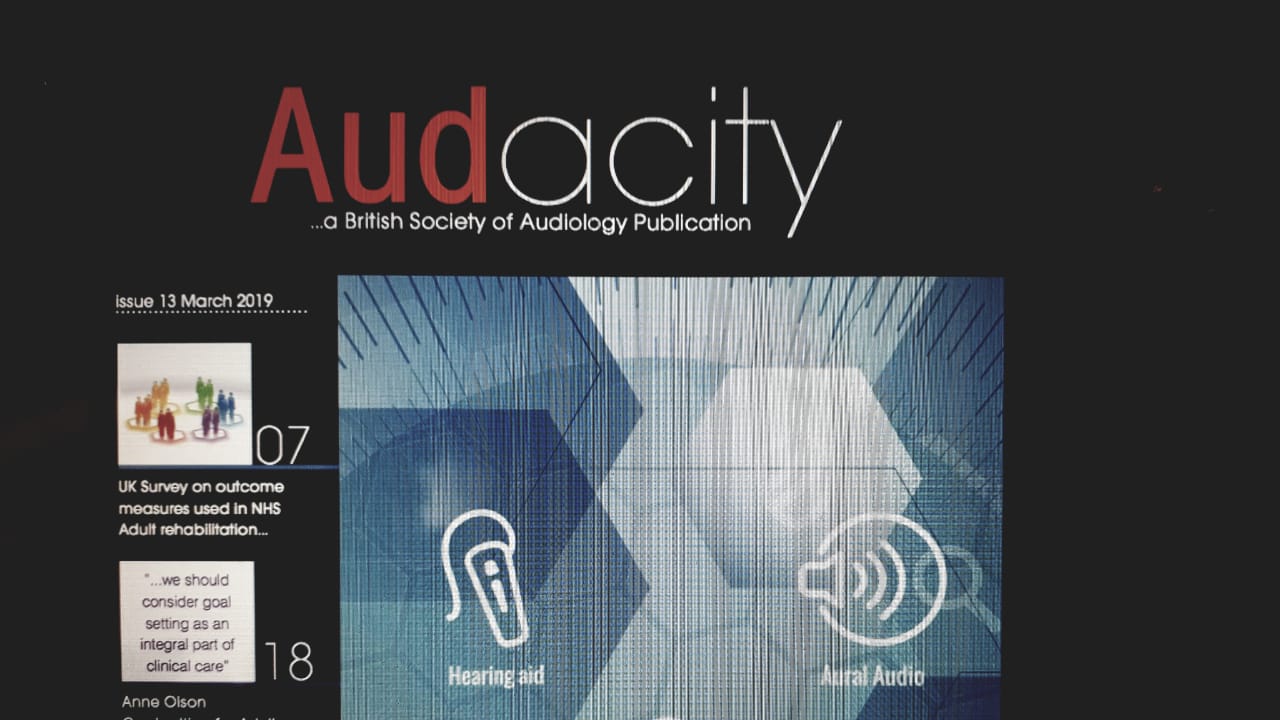
19 Juni Artikel in der Zeitschrift “Audacity”
Audacity ist die Zeitschrift der “British Society of Audiology” (BSA) und es gibt 2 Ausgaben pro Jahr (Frühling und Herbst). Ein Kapitel der Zeitschrift thematisiert unterschiedlichste Projekte außerhalb des Vereinigten Königreichs (Ear Globe). In der März-Ausgabe durfte ich deshalb einen Artikel über die Arbeit in Nepal verfassen.
“Demons in my ear – Stories of ear disease in the Nepalese Himalaya”
I’m sitting in a small house in the Himalayas, it is already dark outside. An open fire in front of me is burning and smoke is all over the room. An older lady is cooking “Dhido”, a local food, in a pan on the fire. She doesn’t seem bothered, but my eyes are burning and I feel discomfort breathing as I listen to her, telling me a story. A story about ear disease and where she believes it comes from:
“Once there was a person suffering from ear disease and ear pain. But it was actually a demon couple living in this ear. They’ve built their house inside and had 5 sons. The person tried everything to treat his ear disease, but nothing really worked. So, he approached the local Lama who finally had a brilliant idea. They put different green leaves around the affected ear and performed sounds with their drums right in front of the ear. Inside, the demons thought it must be summer and they finally can go outside but somehow weren’t sure. So, they sent their oldest son to look. He went outside and saw green leaves and heard sounds like rain and thunder. He went back and reported to his parents. They were still not convinced and sent one son after the other. All of them told the same: green leaves, rain and thunder. The demon mother finally had a look as she just couldn’t believe it. And she as well saw the green leaves and heard the rain. She was finally convinced and the whole family left the ear and the patient was without ear disease or pain.”
I am an Austrian trained Audiologist / Speech and Language Therapist living and working in Nepal. I was a volunteer at a new specialist ear center in Western Nepal for 3 years and now I am living with my husband in a mountainous area of Eastern Nepal.
Nepal is a landlocked country located between India and Tibet / China. It is a developing country still recovering from a civil war which officially ended with a peace agreement in 2006, and prone to frequent natural disasters, like earthquakes and landslides. Geographically, the country can be divided into 3 areas: the lowland plains in the south, the middle hill region and the high Himalayan regions in the north. There are also many socio-economic, cultural and ethnic divisions. The northern part of Nepal, is primarily inhabited by indigenous Tibetan ethnic people groups such as Sherpa, Lowa or the Singsa Lhomi. They share similar beliefs and traditions, are usually Buddhists and speak Tibeto-Burmese languages (Wikipedia 2018). Most of them have never heard of terms such as middle ear infection, audiology or hearing aids. They are unaware of the consequences of ear disease and hearing loss and the impact these have on an individual. How hearing loss affects language learning, future education and employment, and how a foul-smelling ear stigmatizes, and reduces a girl’s chance of getting married. The people don’t know what can be done, or how they can prevent and treat ear disease and hearing loss. They mainly trust local medicines and approach the local priest if health problems occur.
Health care services in Nepal are provided in primary, secondary or tertiary government facilities, in private clinics or through various non-governmental organizations, with most of them concentrated in urban areas. Provision of ear and hearing care services is unsatisfactory with only a few districts offering specialized services (Central Bureau of Statistics 2014). Ear Aid Nepal (EAN), a UK charity, was established to reduce the impact of ear disease and hearing loss and support local health care institutions and training. They work closely with the International Nepal Fellowship (INF) and helped to build, set up and now run the Ear Center at Green Pastures Hospital (GPH) in Pokhara. EAN is a UK charity promoting good ear health in Nepal and treating people with ear disease and / or hearing loss through various projects; in particular by fundraising, professional networking, teaching, research and connecting volunteers. One goal is to reach out to the community in areas with limited access to specialized health care facilities, provide ear health education and primary health care (Ear Aid Nepal 2018).
I’m on my way up to Chepuwa which is a small village in the Eastern part of Nepal (Sankuwashaba District). They told me it’s near the Tibetan border and must be beautiful. But all I can think of at the moment is how on earth I will make it up there. We took a bus from Kathmandu to Khandbari (district headquarters). It took us 28 hours to get there. My google maps app says it is approximately 400km. After a good nights sleep in a beautiful hotel we took another vehicle, a Jeep, which is now bringing us up to Gola, a small town. And from there we’ll walk. We’ll walk for 2 days, up and down the mountains.
Nepal with its mountainous terrain, insufficient infrastructure and limited health care facilities is generally home to traditional medicine. There is one healer for every 100 people, using herbal medicines, mineral substances, animal materials or other methods to treat patients. Knowledge is passed on orally and depends on local customs, available resources, spirituality and religious beliefs. Communities often believe that diseases are caused by evil spirits. Moreover, that a certain god or evil spirit is disappointed with the patient, who must have done something wrong. So, they first treat their diseases at home with herbal medicines available locally, or through local religious practices. If seriously ill, the patient or his / her family would approach a local Buddhist priest (Lama) who would perform a certain sacrifice (mainly animal sacrifice). This is meant to satisfy the spiritual world, bringing back peace with human beings. The last step would be seeking help at a local health post, when already seriously ill and potentially irreversible consequences may already be present (Kunwar et. al 2010).
A local health post worker in Lingam (Sankuwashaba District, East Nepal) reports that ear disease and hearing loss are among the most prevalent complaints patients present with at his clinic. Ear disease and hearing loss are major public health issues worldwide, but numbers are unevenly and unequally distributed with prevalence rates being especially high in developing countries such as Nepal. Not only does ear disease and hearing loss significantly impact an individual’s life, it also has an economic impact on a country. Unaddressed hearing loss is believed to pose an annual cost of 750 billion international dollar annually, so it should be addressed adequately, and public health strategies should target prevention, screening and early intervention (World Health Organization 2017, World Health Organization 2018).
Since January 2018, I’ve been working with NELHOS (Nepal Lhomi Society), a local NGO. They are running a small health post in Lingam, a remote town in the North East Himalayas, near Chepuwa. Our aim is to provide quality services to the local community, to raise awareness about prevention and treatment of common diseases and connect with specialized centers for referral when necessary. The local community has a unique health-related belief and behaviour system which is based on and shaped by their religious beliefs and practices. Although health care facilities are available and accessible, people don’t seek treatment or advice at the clinics. How can they be reached and how can health-related behaviour be changed and transformed?
First step is to reach out to the people and community and talk about ear disease and hearing loss. And this is what we’re doing. We’re going out to the community and especially schools to talk about ear disease and hearing loss, their consequences and impact if untreated, and the importance of check-ups, and what can be done.
Up to now we have visited 3 local schools, developed some outreach material and started cleaning ears, as smoke and dust are contributing to ear wax accumulation. We even had family members of the school children coming into the clinic asking for ear syringing or with other questions related to their ears. Our small team was very encouraged by that and we could see how our education is reaching beyond the people who came. Our goal is to continue with these awareness programs and identify children who need further diagnosis and treatment. We are developing telemedicine and smartphone options to aid diagnosis and referral with the Ear Center in Pokhara (EAN, INF).
I believe that one of the main keys to successfully address the burden of ear disease and hearing loss in developing countries such as Nepal is teaching local health post workers, educating the community and raising awareness as well as connecting health care facilities together.
References
EAR AID NEPAL (EAN), 2018. About us. [online]. [viewed 27 June 2018]. Available from: https://www.earaidnepal.org
KUNWAR, R.M., SHRESTHA, K.P., BUSSMANN, R.W., 2010. Traditional herbal medicine in Far-west Nepal: a pharmacological appraisal. Journal of Ethnobiology and Ethnomedicine. Vol. 6, no. 35.
WIKIPEDIA, 2018. Nepal. [online]. [viewed 27 June 2018]. Available from:
https://en.wikipedia.org/wiki/Nepal
WORLD HEALTH ORGANIZATION (WHO), 2018. Addressing the rising prevalence of hearing loss[online]. [viewed 27 June 2018]. Available from:
http://apps.who.int/iris/bitstream/handle/10665/260336/9789241550260-eng.pdf?sequence=1&ua=1
WORLD HEALTH ORGANIZATION (WHO), 2017. Global costs of unaddressed hearing loss and cost-effectiveness of interventions – A WHO Report[online]. [viewed 27 June 2018]. Available from:
http://apps.who.int/iris/bitstream/handle/10665/254659/9789241512046-eng.pdf?sequence=1





No Comments